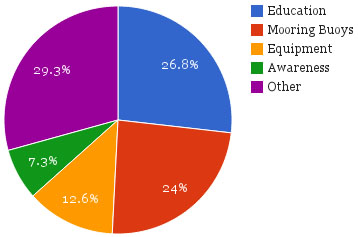 By Sophia Anner, CORAL Intern and student at Albany High School
By Sophia Anner, CORAL Intern and student at Albany High School
As a student in the Environmental Design, Science, Engineering, and Technology (EDSET) program at Albany High School in Albany, California, I get to take courses with an emphasis on the environment, as well as intern with an environmental organization. I chose CORAL because I have always been interested in the ocean, especially as a child, and I thought learning about coral reefs would be especially intriguing since I previously didn’t have much knowledge about them.
This semester, I’ve been researching CORAL’s microgrant program. I first compiled all of the archived information that existed on the microgrants they’ve handed out and sorted them by location. I then analyzed the data and wrote up a final report showing which categories of microgrants received the most grant money and how that money was used.

Since 1995, CORAL has given out 96 microgrants to 17 different countries. The total amount of money given out by CORAL is $589,724.07. The two countries that have received the highest number of microgrants were the United States and Honduras. In the United States, 21 of the 22 microgrants were given to support projects in Hawai‘i (Figure 1).
The microgrants were used for four major purposes: education, mooring buoys, equipment, and awareness. Education has been the most popular category, with 38 microgrants totaling $157,772.95. In many communities around the world, those who depend on coral reefs for livelihoods and other benefits may not understand what a coral reef is, or even that coral reefs are responsible for the benefits they receive. Education grants were used specifically for workshops, guides, flipcharts, videos, and other resources to help marine recreation providers, community groups, and others learn what coral reefs are, the benefits of protecting them, how they can run their business or organization in a way that helps them, and how to talk to their customers and partners about them.
Mooring buoys were the second largest category for microgrants. Mooring buoys are a necessary tool used to mark boundaries of marine protected areas and to anchor boats so that coral reefs are not destroyed. CORAL gave $140,837.60 to 22 mooring buoys projects, which funded 300 new buoys, along with additional training or maintenance. Sixteen projects were related to purchasing new equipment, including boat engines, monitoring tools, and cameras that help reduce poaching and catch rule breakers. These tools help protect coral reefs by ensuring marine protected areas are effectively managed and regulations are enforced. The total amount CORAL gave to equipment microgrants was $74,454.82. CORAL gave out $43,200.84 to projects that promoted general outreach and awareness, such as advertisements, new signs, and photographic displays. These more general outreach techniques serve to educate a broader public and visitors about the benefits of protecting coral reefs, and build support for ongoing conservation efforts. The remaining microgrants served various purposes, such as setting up new marine protected areas or the general continuation of the conservation of coral reefs. Figure 2 illustrates the percentages of the total money given out by CORAL to each category.

I believe that microgrants can be very useful. Smaller groups or organizations might not get the chance to protect coral reefs without additional funding, and microgrants allow CORAL to work and build support for coral conservation efforts in various countries around the world. I learned that microgrants can be applied to many different categories as opposed to focusing on only a few projects, and I think that makes them beneficial as a way to help coral reefs. Since the microgrant applications are initiated by locals, we get additional insight to what is going on directly with coral reefs in countries around the world.
CORAL staff plan to add to the information I compiled to learn more about some of the long term impacts these microgrants have had. But it’s not hard to see that many of CORAL’s successes today are built on successful microgrant investments of the past.
What do you think of microgrants as a conservation strategy? Let CORAL’s communications team know by emailing communications@coral.org.